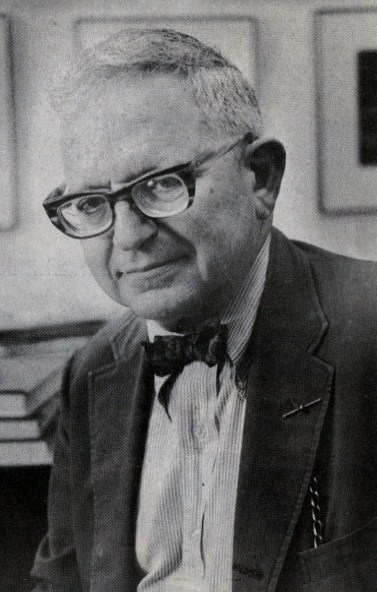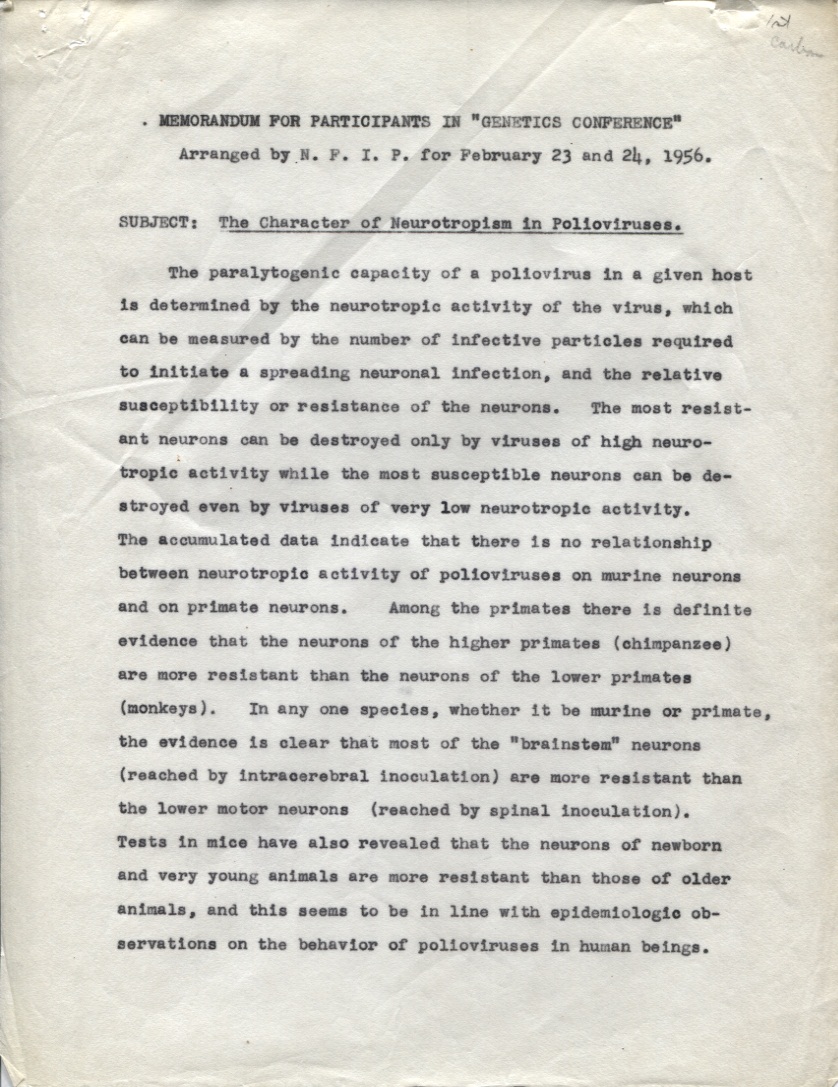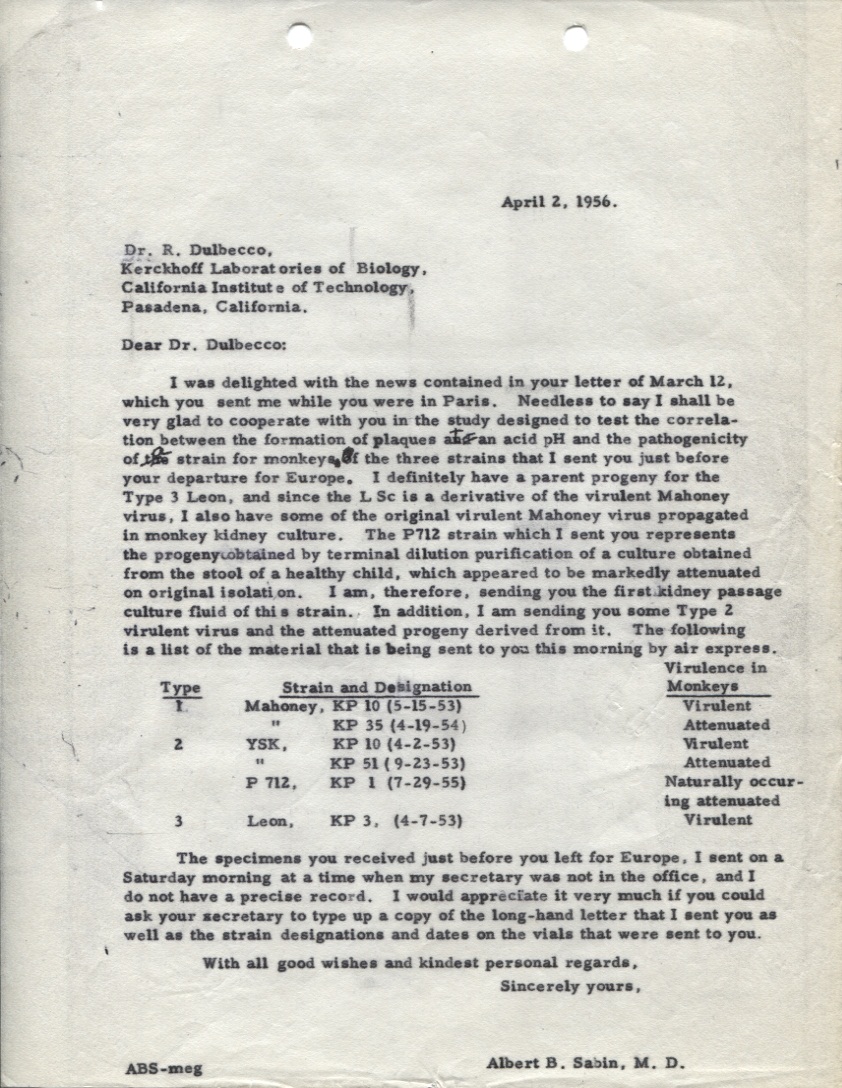Recently, I was reading a chapter on the history of polio research by Saul Benison, a former professor of history at the University of Cincinnati. Prior to coming to Cincinnati, Dr. Benison held a notable position as the historian for the National Foundation for Infantile Paralysis (see a previous blog about this organization). During this time, he wrote a memoir of virologist Thomas Rivers, which received much acclaim when it was published in 1967. While at Cincinnati, Dr. Benison worked extensively on a biography – really an oral history – about Dr. Sabin, but this book was never published.
Dr. Benison’s chapter on polio research began in 1907 with Dr. Simon Flexner and discussed over 50 years of poliomyelitis research. Of course, no history of this disease can be covered without discussing Dr. Sabin. In one part of the chapter, Benison recalled a 1956 conference sponsored by the National Foundation for Infantile Paralysis, which gathered scientists together to help Dr. Sabin in “choosing stable nonpathogenic virus strains” for the oral polio vaccine (p. 331-32). Dr. Benison wrote that the information that Dr. Sabin received from this conference allowed him to “successfully [adapt] Dr. Renato Dulbecco’s plaquing techniques for the selection of attenuated virus strains suitable” for the vaccine (p. 332).
The Sabin collection contains materials related to this meeting. One item I found was a ten page memo written by Dr. Sabin to the participants in the Genetics Conference called, “The Character of Neurotropism in Polioviruses.” Much of the memo contains detailed information about the problems Dr. Sabin was having with his research. His conclusion asks a couple of questions that he hoped to learn more about during the two day meeting. Dr. Sabin asked his colleagues, “[A]re there any polioviruses which are completely devoid of neurotropism for lower as well as higher primates?”, and “[W]hat are the most reasonable and promising lines of investigation that may be suggested by the accumulated experience in other microbial genetic studies?” Dr. Sabin ends the memo with a couple lines about testing individual purified plaques of the three poliovirus strains he was investigating. Of course, this is where Dr. Renato Dulbecco comes in.
Dr. Dulbecco was a professor at the California Institute of Technology, and later in his career, he would be a co-recipient for the Nobel Prize in Physiology or Medicine in 1975 for “discoveries concerning the interaction between tumor viruses and the genetic material of the cell.” Among Dr. Sabin’s correspondence files is a folder with letters to and from Dr. Dulbecco, where I found an exchange of letters sent shortly after the Genetics Conference. Both Drs. Sabin and Dulbecco agree to work together on a project, which involved testing the three poliovirus strains Sabin was working on. Dr. Dulbecco wrote, “[I]t would be worth while [sic] to test some more strains of these three types [of polio strains], but to test also at the same time the original pathogenic strains of each of them. It might be conceivable to make this a joint project of ours and your lab, in which we would do the plaque testing and you would supply the pathogenicity data.” Dr. Sabin agreed with this potential collaboration, as you can see in this letter. He quickly sent off some strains to Dr. Dulbecco for testing.
As we get further along in the project, I plan to look at Dr. Benison’s work on Thomas Rivers, so I can tell a bit more about the relationship between Drs. Sabin and Rivers. Be on the lookout for that blog post!
Notes: Dr. Benison’s “The History of Polio Research in the United States: Appraisal and Lessons” can be found in Twentieth-Century Sciences: Studies in the Biography of Ideas, edited by Gerald Holton (New York, W.W. Norton & Company, 1972). Also, the Winkler Center has a DVD of an oral history interview with Dr. Sabin, which was conducted by Dr. Benison and Dr. Benjamin Felson. Please contact the Winkler Center if you are interested in viewing this oral history video.
In 2010, the University of Cincinnati Libraries received a $314,258 grant from the National Endowment for the Humanities (NEH) to digitize the correspondence and photographs of Dr. Albert B. Sabin. This digitization project has been designated a NEH “We the People” project, an initiative to encourage and strengthen the teaching, study, and understanding of American history and culture through the support of projects that explore significant events and themes in our nation’s history and culture and that advance knowledge of the principles that define America. Any views, findings, conclusions, or recommendations expressed in this blog do not necessarily reflect those of the National Endowment for the Humanities.



